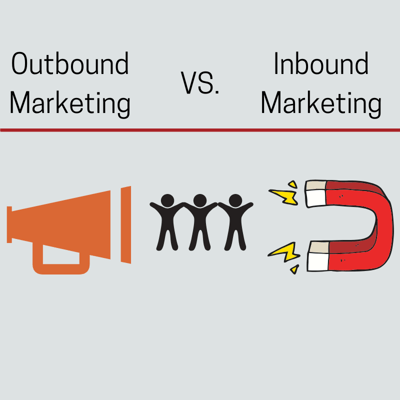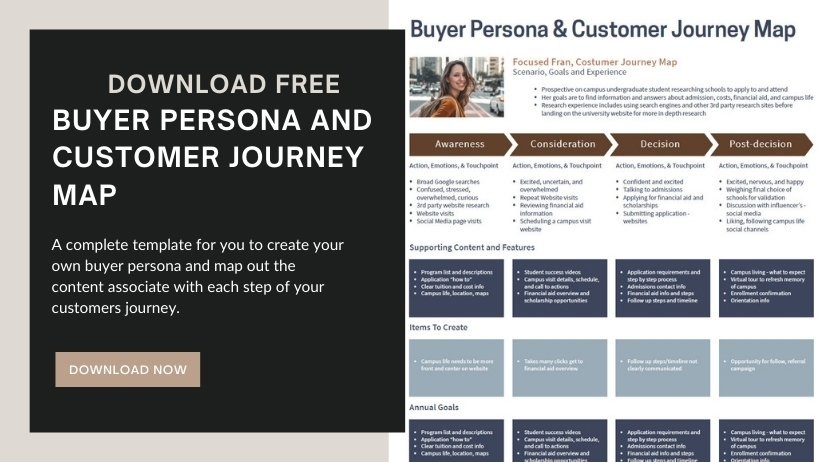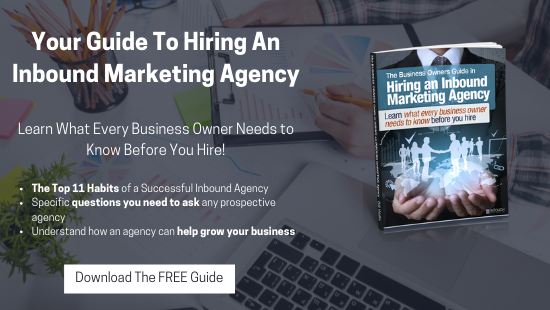How you choose to fill the top of your sales funnel with leads likely involves some type of marketing.
While many small businesses still rely on outbound marketing methods to generate leads, more and more business owners are turning to inbound marketing to generate sustainable results.
While outbound marketing has been around for decades, inbound marketing is quickly becoming the strategy of choice to help businesses meet their growth goals. Although inbound and outbound marketing may both be strategies to draw potential consumers to your business, they are anything but similar.
Let’s compare inbound marketing vs. outbound marketing and explore which one is more equipped to provide sustainable growth for your business.
Outbound Marketing
If you’ve noticed a billboard while driving down the street, received a postcard in the mail from a local business, been to a trade show or received a cold call, you are the recipient of outbound marketing.
Outbound marketing is a more traditional sales approach. It involves a strategy of reaching out to wide masses of people about products or services. You’re essentially throwing a large net, hoping to catch some people who may be interested in what you have to offer. In reality, most people will not.
This methodology relies on a sales funnel that starts with many leads and moves as many as possible through the funnel. Your sales team may attempt to turn them into prospects and then convert them into customers, but the problem is that many of the people you’ve captured at the top of your sales funnel were never interested in your product or service in the first place.
Outbound marketing is costly, and it typically doesn’t produce a high return on investment or ROI. So why do so many businesses still use outbound sales tactics? When newspapers, television and even the Yellow Pages were the main sources of information, it made sense to advertise where your potential customers were.
But times have changed. People now turn to the internet for the information they are seeking, browsing search engines, blogs and social media for answers. Yet change is hard, and people have grown accustomed to using a marketing strategy that has been established for several generations.
The problem is that outbound marketing is becoming more widely known for being “disruptive” or “interruptive,” meaning they are poorly targeted and rely on a conversation with individuals who don’t want to have that conversation. And the offers you’re pushing in the hopes you’re catching someone at the right time are often through expensive channels, such as newspaper and TV advertising.
The result is a poor investment for your business and little growth.

Inbound Marketing
Inbound marketing allows customers to come to you. Rather than pushing your message in front of people who may or may not be interested in the product or service you are offering, inbound marketing instead establishes you as an authority in your industry.
Using inbound marketing techniques, customers searching the internet for your product or service will naturally discover your brand.
Your prospects receive your message on their terms, making them far more receptive to what you have to say. You also spend little to no time convincing prospective customers that they need a product or service you offer. They’re already looking for it. Now that they’ve found you, you can focus on educating them about why you’re the best option to help them meet their needs.
A successful inbound marketing strategy focuses on solving problems and providing answers. It requires an intense understanding of not only what customers need throughout their buyer’s journey but also understanding any anticipated questions they may have.
5 Fundamentals
Inbound marketing is built upon five fundamentals:
-
Contacts
-
Buyer Persona
-
Buyer’s Journey
-
Content
-
Goals
A contact is anyone who engages with your business. Keeping track of your contacts is important, especially as you develop relationships with them and they become quality leads.
A buyer persona is a fictionalized representation of your ideal customer. Knowing who your ideal customers are is very important because your marketing plan will be based on a strategy that shares how you can solve their problems and meet their needs.
The buyer’s journey is the process your ideal customer goes through, from awareness to consideration and decision. In the awareness stage, the buyer has a problem and is experiencing symptoms. In the consideration stage, the buyer is committed to solving this clearly-defined problem. In the decision stage, the buyer is compiling a list of products or services that can solve this problem.
Carefully-crafted content brings these contacts to you so that you can turn them into customers, essentially convincing them that your business can be the one that solves their problems. The most effective content is targeted, detailed and provides value. It is also optimized so that it performs well on websites like Google.
Goals should be measurable so that you can determine what’s working and what isn’t working. Setting goals and keeping track of your progress are essential. They should be SMART, Specific, Measurable, Attainable, Relevant and Timely.
Methodology
The inbound marketing methodology is based on growing your business through meaningful, lasting relationships with consumers, prospects and customers. There are three phases in the inbound marketing methodology:
-
Attract
-
Engage
-
Delight
The Attract phase focuses on “drawing in the right people with valuable content and conversations that establish you as a trusted advisor with whom they want to engage,” according to Hubspot.
Your buyer persona is particularly important in this phase since you need to identify potential customers’ challenges, pain points, goals, and common objections to products and services like yours. Once you have this information, you can develop marketing content (blogs, social media and other content offers) that helps attract your buyer personas to your website.
The Engage phase focuses on “presenting insights and solutions that align with their pain points and goals, so they are more likely to buy from you,” according to Hubspot.
In the early part of this phase, you’ll develop prospects into qualified leads. Your goal should be to convert and close a prospect by the end of this stage. While you’ll only typically need their email addresses at the beginning, as prospects move down your sales funnel, you’ll likely want to request more information in exchange for something valuable you provide to your prospects (such as an ebook).
Closing tools you may use to engage prospective customers include Customer Relationship Management (CRM) software, email and marketing automation.
The Delight phase focuses on nurturing the customer and developing a long-term relationship. Social media is a great way to delight customers because it provides a platform for them to ask questions and share feedback. Other tools that fall under this phase include surveys, calls-to-action and smart text.
The Flywheel
Although we’ve talked about the sales funnel above, your digital marketing funnel is really more of a flywheel. The flywheel incorporates the same components as a sales funnel but instead puts a customer at the center. This creates a less linear approach to your lead generation activities and represents the fact that each action taken by a team member impacts another action.

Today, potential clients now rely more on third-party advice from review sites, friends or mentions of your business on social media. Funnels don’t incorporate any momentum you build, but flywheels do. Improving your internal processes will make your flywheel spin faster.
As you can see in the flywheel above, this design incorporates the three inbound marketing methodology phases, as well as all the components that go into building momentum, from your team members to how individuals develop from prospects to customers and beyond.
Inbound Marketing Tools
While outbound marketing tools often focus on physical pieces of advertising, like flyers or newspaper advertisements, many inbound marketing tools revolve around the internet.
Examples of inbound marketing tools include:
-
Blogs, which are among the top three media forms used in content marketing strategies (Hubspot, 2020)
-
Search engine optimization (SEO), which uses keywords in your blog and other content to increase performance in search engines like Google, as well as other strategies like using title tags, meta descriptions, alt text and images
-
Social media, like Facebook, YouTube, Twitter, Instagram, Snapchat, LinkedIn and Pinterest (it’s important to use the social media sites that your customers use)
-
Content offers, like checklists, eBooks, video tutorials, white papers, how-to videos and buyers’ guides
-
Forms, which allow you to develop your contact list and should be optimized to make it as easy as possible for contacts to provide their information in exchange for content
-
Calls-to-action, which appear as buttons or links that encourage your visitors to take action, such as “download a whitepaper” or “request a free quote”
-
Surveys, which are excellent ways to figure out what users want and need through feedback
-
Website, which holds all the content you generate and serves as a gateway for you to gather potential customers’ information (your website should be mobile-friendly)
Inbound Marketing Vs. Outbound Marketing: Which Is Better?
Let’s break down the main differences between inbound marketing and outbound marketing:

So which is better for your business: Inbound marketing or outbound marketing? Nearly 81% of shoppers research a product or service they want BEFORE buying. As technology has evolved, so has the method by which consumers choose what they’re buying and when they’re buying.
Inbound marketing offers several benefits for small businesses, including:
-
A higher level of cost-effectiveness and ROI
-
Sustainable content that is continually shared and promoted on the internet (versus traditional advertisements that stop when you end payment)
-
Name recognition and authority as you increase your keyword rankings and improve your brand recognition
-
Quality traffic and leads for your sales staff
-
Better relationships with your customers
-
Easier to track ROI and metrics
-
The opportunity to educate your audience
-
A modern marketing approach for your business
Inbound marketing strategies are evolving and growing, and if your business isn’t yet prepared for the digital age, you could be missing out on valuable leads.
Source link




